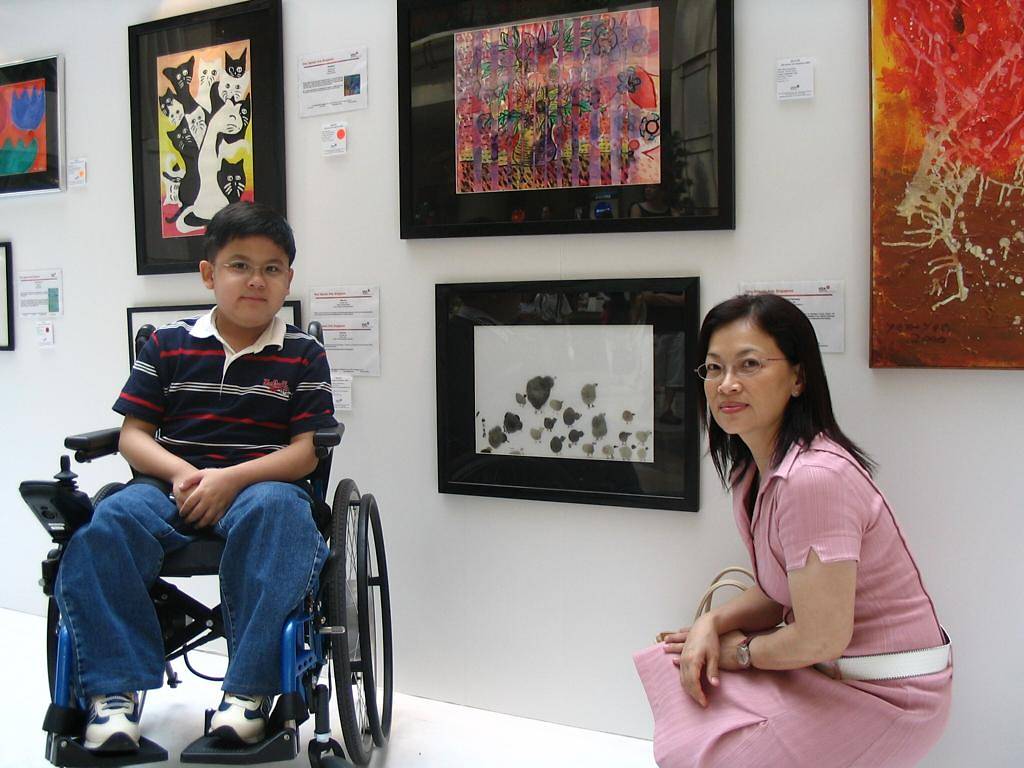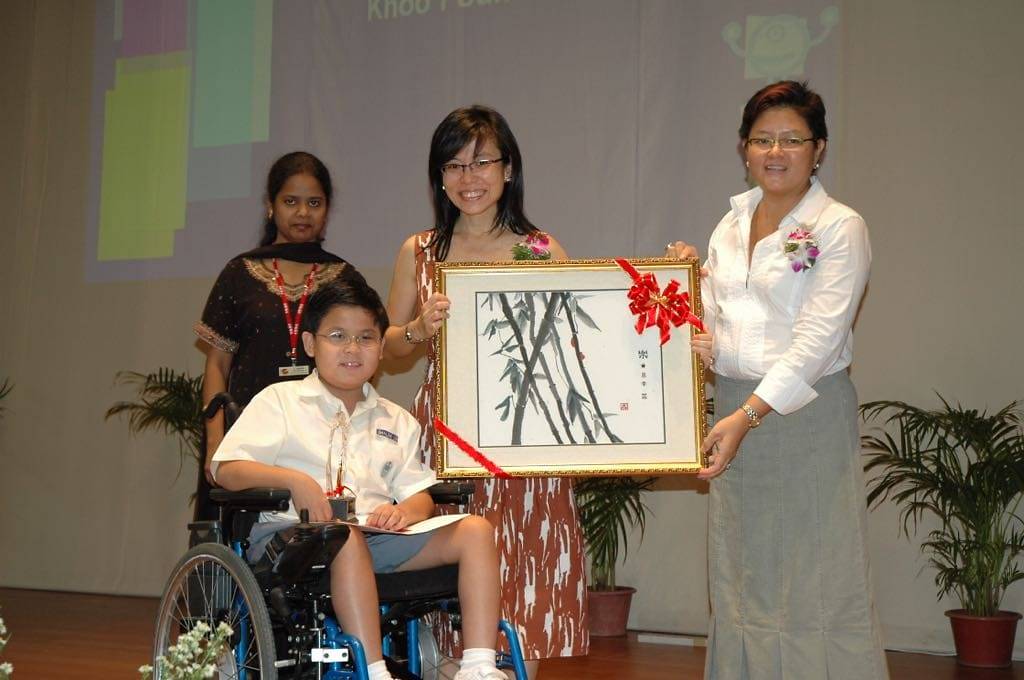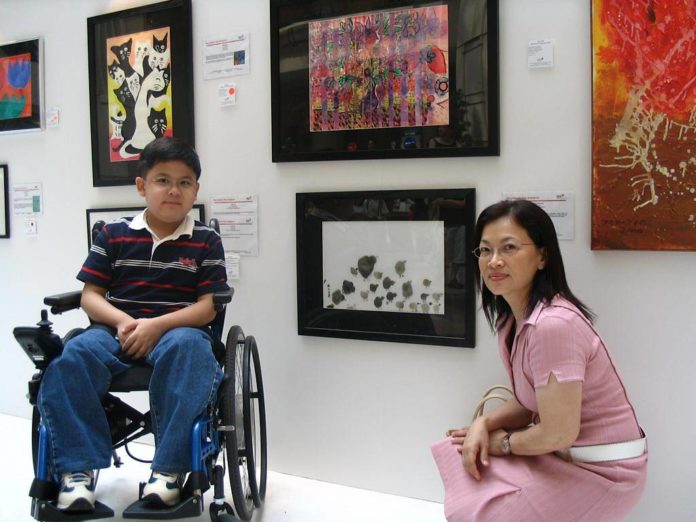SINGAPORE: Shalom Lim, 23, suffers from Duchenne Muscular Dystrophy, a degenerative muscular disease.
He has been using a wheelchair to get around since he was six years old, but as his condition worsened, he found it a struggle to complete his exams.
“In Primary 4, I experienced some difficulty in keeping up with the time,” said Shalom. “One of the exams I did in class, I didn’t have time to finish it. So the teacher gave me more time. I was still in the class and I didn’t feel very comfortable. In the end, they allowed me to have a separate room.”

Shalom Lim has been using a wheelchair to get around since he was six years old. (Photo: Grace Lim)
In secondary school, Shalom found it impossible to do his science practical assessments at all. So in Secondary 3, he applied to be exempted from the component for his O-Levels. This was approved in Secondary 4, after months of anxious waiting.
“The Ministry of Education (MOE) requested for assessments done by an occupational therapist to show that I wasn’t able to do the O-Level science practical exams on my own.
“We were wondering why there was a need for such a letter when I could clearly show them I had mobility issues,” he recalled. “In the end, they granted us the exemption only after we sent in a few requests.”
Last year, about 5,000 students – or 4 per cent of those sitting for national exams – applied for such special provisions or what is called “access arrangements”, which include extra time, larger print on exam papers or even a scribe.
The number of such applications has doubled over the last decade, MOE told Channel NewsAsia, adding that this is due in part to greater awareness of the access arrangements available.
There has also been a growing number of students with special educational needs in mainstream schools, as there is now greater access to diagnosis such as through the school-based dyslexia remediation programme that was fully rolled out to all primary schools in 2016.

Shalom Lim told Channel NewsAsia that he wished requests for special exam provisions coild be made more seamless. (Photo: Grace Lim)
Requests for special exam provisions are evaluated by a panel, which will look at reports from a health professional and the student’s teacher, as well as school exam results to gauge how the student is coping academically.
While this process is meant to make sure that proper checks are in place, it can also result in a long wait as in Shalom’s case.
“I think they could be less strict about it. And make it more seamless for us,” said Shalom. “At that time, we wished they would have given it (the exemption) faster without a need to engage an occupational therapist. I do hope that they have made the procedure easier for us.”
“PLEASE DON’T COME’’
Exams are just one hurdle for students like Shalom.
Currently, 57 primary schools offer barrier-free accessibility for students with physical disabilities, according to MOE’s website. That is less than one-third of primary schools in Singapore. And the figure goes down as students move up.
Those preparing for the A-Levels or the International Baccalaureate have just three barrier-free options – Raffles Institution, Millennia Institute and Anglo-Chinese School (Independent).
Shalom’s mother, Mrs Grace Lim, said that was one reason why they chose to take the polytechnic route after his O-Levels.
“None of the junior colleges were welcoming or had the accessibility to support him at that point in 2012. I remember approaching at least two JCs and they said: ‘We are not set up to support a person in a wheelchair, so please don’t come’.”
Still, Mrs Lim stressed that some schools have been willing to go the extra mile for her son, even if they lacked the necessary infrastructure at the start. For instance, staff members at his primary school carried him up and down the stairs, until a sponsor stepped in to pay for a ramp. His secondary school already had ramps installed, and when he got into polytechnic, Shalom’s course manager took them around campus and showed them the accessible routes.
Both mother and son believe things have improved.
Today, all mainstream schools can provide some form of support for students with mild special educational needs, including learning difficulties like dyslexia.
According to MOE, most primary and secondary schools have at least one allied educator who is trained to help these students. There are also designated mainstream schools that can provide specialised support for specific disabilities, such as hearing loss or visual impairment.
At the higher level, all Institute of Technical Education colleges, polytechnics and autonomous universities now have support offices that work with academic staff to provide course counselling, classroom support and access arrangements.
Shalom is now taking a Criminology and Security degree course offered by the University of Liverpool, which is conducted at Singapore Institute of Technology. The varsity has given him three extra years to complete his degree and excused him from internships, which are typically graded.
Mrs Lim noted that while schools have become more informed about how they can help, the family often had to take the lead by constantly engaging them on Shalom’s needs.
“We are more proactive and pre-emptive because we wanted our child to have a very good education experience,” said Mrs Lim. “Life is tough enough as it is for him already, and we wanted to make it as seamless as possible.”
COPING WHEN ILLNESS HITS
For those whose condition isn’t visible, it might be even more important to voice their needs.
Take 20-year-old Rayna Tan for instance. While she looks like a regular polytechnic student, she was born with biliary atresia, a liver condition which prevents toxins from being flushed out well.
Rayna Tan had to drop out of her polytechnic course after a major operation, but the school allowed her to continue with her studies a year later. It even granted her extended deadlines for projects. (Photo: Deborah Wong)
Two years ago, her mother donated part of her liver to her after a bout of infections threatened her life.
“I actually went through a transplant, but I would say the toughest period would be post-transplant when I had a lot of complications. I had to stay in the hospital and receive antibiotics through a drip, so it meant my days were packed with hospital visits and I wouldn’t have time for school,” Rayna said.
She withdrew from her Visual Effects course at Ngee Ann Polytechnic to recuperate, but after a year in limbo, the family approached the polytechnic, which agreed to let her pick up where she left off.
“Even though I withdrew, the school still allowed me to return without a proper admission. So they did all the paperwork after I was already attending classes,” she said.
Rayna was also assigned one of her course lecturers as her adviser.
“Every year, the school conducts training for the staff like basic counselling, or how to create a nurturing environment for students with vulnerabilities. In Rayna’s case, we as lecturers stepped in to discuss how to help her,” said her adviser Jeffrey Zauhari.

Rayna Tan had to withdraw from her Visual Effects course at Ngee Ann Polytechnic (NP) to recuperate. (Photo: Rayna Tan)
Mr Jeffrey said he gives Rayna extended deadlines for projects if she’s not feeling well or has a medical appointment.
He added that it is easier for him to know what she needs as she is willing to speak up.
“In Rayna’s case, I was notified by the school, so I used a differentiated learning approach to help her individually when she has problems in class. Rayna is the type who raises her hand to ask questions. She is very diligent. So it’s easier for me to help her in that sense,” he said.
According to MOE, post-secondary education institutions like the polytechnics provide support for students who miss school for extended periods due to medical reasons.
In some cases, school employees who have been assigned as their personal mentors will meet them at least once a month to help them with the transition back to school. The ministry added that some schools also provide additional lessons to help them catch up.
Mr Jeffrey noted that it is important for parents to flag their child’s condition, to make it easier for the school to identify and help those who need support.
“Once we identify the vulnerable students, we’ll monitor them. We have para-counsellors in schools for me to refer to if I cannot handle the students myself. We also collaboratively discuss how to help them, because these students need consistent monitoring throughout all the modules.”
“I DON’T KNOW IF THE OUTSIDE WORLD WILL BE UNDERSTANDING”
Rayna has one more year to graduation, barring any more lengthy hospital stays.
A polytechnic student has five years to complete a diploma at a subsidised fee, and Rayna has already dropped out once. While the school has assured her that concessions will be made if needed, she worries that the focus on attendance could be an issue.
“There are days I feel tired and I really need to rest a bit more, but I would still have to go to school,” she said.
Rayna is also worried about what would happen after she enters the workforce, as the infections can hit suddenly and last for prolonged periods.
“I don’t know when they will come. So I worry about the commitment level to internships and work life next time, because I don’t know if the outside world will be as understanding as the school.
“My hope is that companies and people would be more understanding towards people with medical illnesses, especially if you can’t see it on the outside,” said Rayna.
“People will judge and question why this person always takes MC. Sometimes it’s because it gets very tiring.”





